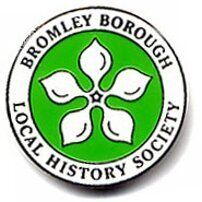Bromley Borough Local History Society
Registered Charity
No. 273 963

Bromley Borough Local History Society
We started at the main gate (which is not used by the general public today) and the lodge house seen in the picture below. In the 19th century, the drive continued across Shire Lane and joined Church Road directly below the church. Members of the Lubbock family were buried adjacent to the drive, apparently on unconsecrated ground. This gate was also the site of a serious carriage accident involving a member of the Lubbock family.
A detail of the gate pillar decoration can be seen with a Medusa head, although the reason for this is not known.
A plaque commemmorating the life of High Elm's most famours resident.
We then made our way up the drive which was created by cutting down many old trees, but replacing them with a selection of cedars, pines and redwoods, sourced from Kew Gardens.
The one advantage of the recent wet weather was the lush green of the grass and trees that might othewise have looked rather drab (I am trying to be optimistic!). The modern wall on the right in the picture below is the garden of the lodge house.
This picture is taken looking back towards the entrance from a point near today's car park.
Although ice houses, for keeping blocks of ice stored in the winter available during the summer, are not uncommon (they can be seen at the Rookery and at Kelsey Park for example), this structure is massive.
After unlocking the gate and making our cautious way down the stairs, we passed a small storage chamber (which was added to the original structure) and arrived at the gate (also added at a much later date) to the main chamber.
Above is the gate to the ice well itself.
It is difficult to get an idea of its depth (about 30 feet) but the bricks are standard size. At the bottom of the well is a drainage hole for the melt water. Access was via a rope or wooden ladder.
The roof of the ice well through which the blocks of ice, probably imported from Scandinavia, were dropped. It also gives another view of the complex and very thick brickwork. The camera has given a slightly strange impression of the dome and access hatch which can be seen from outside.
Near the ice house is the Eton Fives court, below, built in the mid 1850s. An early form of squash but played without a raquet, several Lubbock children attended Eton and brought the game back to High Elms. The "pepperbox" on the left is original but not the top brickwork which was probably added in the 20th centurey to cut down on broken windows in the Coach House behind,
The Coach House is now used as the estate office.
Opposite the coach house are the stables, which have also been converted. The positition of the original doors into both buildings can be seen from the breaks in the flintstone walls.
The current path to the cafe and grounds turns left half way up the drive but originally it carried straight on, ending in an entrance circle outside the front door. This shows the location of the front door, between the new hedge and the now planted area, where horses and carriages once turned.
The location of the house from the back looking toward the front drive seen in the previous picture.
Some of the original gardens remain, including the conifer walk down to a pond.
The location of a formal garden.
In addition to the gardens, some of the smaller structures built around the house over the years on what was originally a 276 acre estate have survived, albeit with some help and despite the repeated attentions of vandals. The summer house with its York stone roof has had to be fenced off to stop the tiles being removed!
The Grotto, has also suffered damage but this was apparently caused by a falling tree.
For his 79th birthday present in April 1913, Lord Avebury's second wife Alice had the Birthday House built. Originally it had a clock and golfing figure above the entrance. Sadly her husband died only a month later. Inside she had an inscription placed with a verse of her own:
"A birthday gift to greet him when he came home from the weary town. Fourscore save one.
He heard and smiled his thanks, but Ah! The flame of life burned low.
Soon we were left alone yet love survives and while this clock doth chime,
It tells of love outlasting measured time."